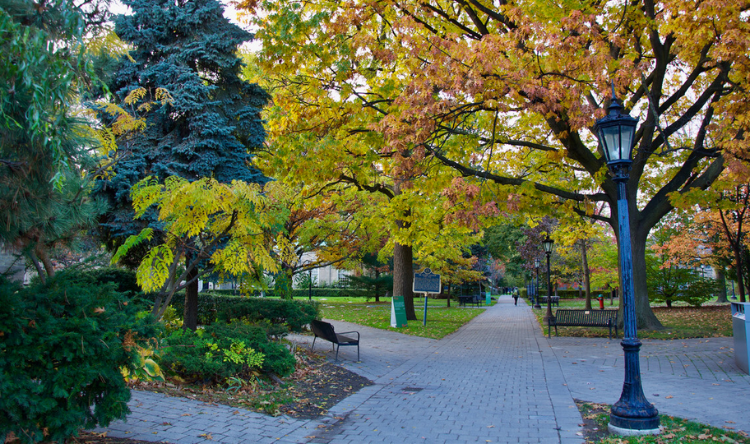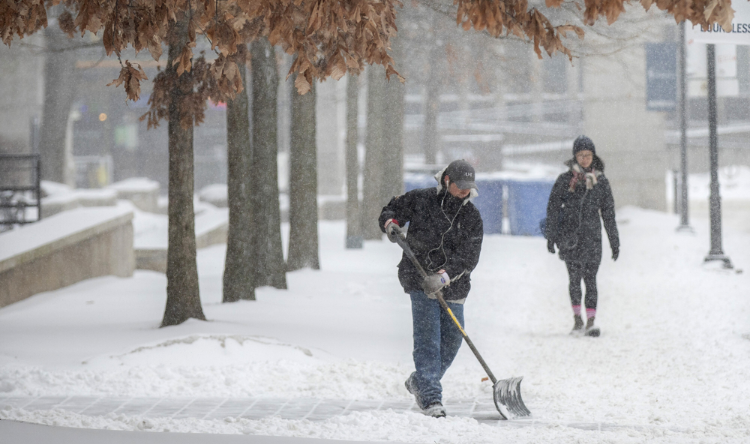Nine ways F&S ensures the campus is prepared for the cold season
From turning on heating to getting snow removal tools ready—F&S dedicates significant effort come season change to prepare the campus.
As the summer heat fades and the leaves start to brown, Facilities & Services works hard to prepare the St. George campus for the cold season. Here are some of the ways F&S ensures that the campus is well-prepared for fall and winter.

1. Clearing walkways and tending gardens
As the leaves begin to fall, we ensure that pathways and gardens remain clean. We collect and compost fallen leaves—using mulchers to shred them—to reintroduce valuable nutrients into the soil and gardens.
2. Protecting the irrigation system
When temperatures fall, the water in the irrigation system pipes could freeze and cause widespread damage. To prevent this, we perform an irrigation blow down during the fall. This involves turning off the water and using an air compressor to blow all the water out of the lines.
3. Winterizing chilled water systems
As wintry weather approaches, we turn off most of our chilled water systems that keep building occupants comfortable in the summer. To do this, we drain all 1200 chilled water coils on campus, which cool or remove moisture for the ventilation systems—and keep them dry and protected by blowing conditioned air through them.
Many of the pipes on campus are used for both heating and cooling. So we shut off the chilled water and slowly, and then heat the chilled water over two days so that buildings are warm during the winter months.
4. Inspecting the steam tunnels
A two-kilometre network of tunnels spans U of T’s entire downtown campus, carrying steam into campus buildings through insulated piping.
We conduct a walk-through of the heating distribution system twice a year to ensure everything is in working order—once before the annual shutdown in the summer and again in November.
5. Switching to heating via the Central Steam Plant
The Central Steam Plant generates up to 6.4 megawatts of power, enough to meet the immediate energy needs of more than 4,500 residential homes. The plant is responsible for heating most buildings on campus.
On August 24, we completed the annual shutdown—inspecting and maintaining the heat-producing equipment—to ensure we can provide uninterrupted heating for the campus during the colder months.
6. Turning on the boilers
Five boilers in the Central Steam Plant provide heating and hot water to 75 buildings on the St. George campus, while two buildings have stand-alone boilers. Combined, these boilers produce up to 550,000 pounds of steam per hour.
Typically, after Thanksgiving, we start up the boilers.
The duty engineer will monitor the heat loading on the boilers and start up an amount based on the heat demand of the buildings. The boilers operate on a cogeneration system—producing electricity and heat simultaneously as opposed to separately—thereby promoting sustainability.
7. Salting pathways and snow removal
“There is nothing prettier than our historic campus after a snowstorm,” says Steve Barratt, senior property manager.
However, with this beauty comes an increased responsibility for maintenance.
To keep everyone safe while moving about campus, F&S staff clear the pathways as needed. After a heavy overnight snowfall, the grounds team arrives early to plow, shovel, and salt. If there is an unusual amount of snow, the team brings in contractor back-up.

8. Posting safety signage
To communicate potential seasonal hazards, safety signage is posted around campus; these warnings include reminders about ice and weather-appropriate footwear.
9. Cleaning up winter
During the winter months, caretakers use wet vacuums designed to clean up liquid spills and wet debris, and I-mops to clean up excess water found in entranceways, on carpets, and floors. I-mops clean faster than conventional wet mops because they allow mopping at full walking speed—eliminating back-and-forth trips.
We lay down seasonal walk-off mats at building entrances for people to dry their shoes—minimizing slips and preventing water damage to flooring.
As the seasons change, so do the thermal systems.
If you feel the heating or cooling systems in your work or study spaces may not be working properly, submit a service request. A building engineer will respond and investigate your concerns.
